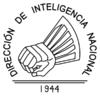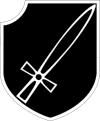Siege of San Salvador
The Siege of San Salvador (Creeperian Spanish – Creeperian: Սիտո ել Սան Սալվադոր; Creeperian Spanish – Iberic: Sito de San Salvador), also referred to as the Battle of San Salvador (Creeperian: Բատաժա ել Սան Սալվադոր; Iberic: Batalla de San Salvador), and known in modern-Creeperopolis as The Siege (Creeperian: Ել Սիտո; Iberic: El Sito), was the largest, lengthiest, and deadliest confrontation of the Creeperian Civil War between the Catholic Imperial Restoration Council (Imperial Council) and the National Council for Peace and Order (National Council). The battle was fought mostly within the department of San Salvador, one of the most strategically and symbolically important regions of the country. Due to its large and complicated nature, the siege has sometimes been considered to be its own war within the Creeperian Civil War.
The siege began in May 1946 with an initial attack by the National Council against forces of the Imperial Council. The National Council's failure to win a quick and decisive victory over the Imperial Council led to a stalemate and long-lasting siege, as neither side was able to break through the other's defenses. A final offensive by the Imperial Council in August 1949 forced a National Council retreat, ending the siege in a decisive Imperial Council victory. The civil war itself would later end on 30 September 1949.
Contents
Name
Due to the extremely complex nature of the conflict, the event has been referred to by several different names. Siege of San Salvador is the most commonly used name, however, the "San Salvador" in Siege of San Salvador refers to the department of San Salvador as a whole instead of the city of San Salvador, located in the center of the department. Other names used to refer to the military conflict include the Battle of San Salvador (not to be confused with other historical battles of San Salvador) and the San Salvador War.[1]
The conflict's two factions also referred to the conflict by differing names. The National Council referred to the conflict as The Final Battle while the Imperial Council referred to the conflict as The Siege. Later Creeperian government officials and scholars have also referred to the conflict as The Siege due to its importance in modern Creeperian history.[1]
Background
Failure of the Papal War
Imperial Council advances in the north
Prelude
Planning and organization
Final preparations
Order of battle
National Council order of battle
The commanders-in-chief of the National Council forces in the Siege of San Salvador were Emperors Miguel VII and Marcos I while its overall military commanders were Chief Field Marshals Juan Salinas Figueroa and Miguel Salinas Ortega. The following is the order of battle of the National Council at the start of the siege:[2]
- North–Lake San Salvador front
Army Group Mauricio Tasis Quesada – Field Marshal José Bolívar Aguirre
- 3rd Army – General Rigoberto Fernán Tasis
- 9th Army – General Ricardo Rosales Román
- 4th Infantry Division (Terranilian) – Major General Adam Gát
- 2nd Flotilla – Admiral Lorenzo Sarmiento Elvira
- 25th Air Force Wing – General Antonio Morterero Nores
- East–central San Salvador front
Army Group Qarl Marx – Field Marshal Miguel Salinas Ortega
- 1st Army – General Alan Hurtado Ros
- 11th Army – General Rubén Alguacil Prats
- 130th Rifle Division (Ajaki) – Major General Ayushiyev Vassili
- 28th Air Force Wing – General Sebastián Pousa Frexia
- South–Volcano San Salvador front
Army Group Joel Lacasa Campos – Field Marshal Pascual Espinar Casaus
- 7th Army – General Pedro Morillo Coronil
- 8th Army – General Antonio Yon Sosa
- 27th Air Force Wing – General Dídac Pareja Campos
- Paramilitaries (various fronts)
- Atheist Red Army – General Secretary Mariano Alcocer Fraga
- National Guard – Chief Guard Ángel Moruga Leoz
- Special Task Squadrons – General José Huerta Milano
Imperial Council order of battle
The commanders-in-chief of the Imperial Council forces in the Siege of San Salvador were Emperors Romero I and Romero II while its overall military commander was Chief Field Marshal Alfonso Cabañeras Moreno. The following is the order of battle of the Imperial Council at the start of the siege:[3]
- North–Lake San Salvador front
Army Group King Saint Miguel I – Field Marshal Juan Primavera Sánchez
- 3rd Army – General Agustín Sarmiento Cruz
- 2nd Armored Division – Lieutenant General Vicente Gutiérrez Serrano
- 4th Mechanized Division – Lieutenant General Martín Menjívar Ulloa
- 5th Motorized Division – Lieutenant General Leonardo Parejas Obregón
- 5th Infantry Division – Lieutenant General Emmanuel Guillén Rubio
- 8th Artillery Division – Lieutenant General Alfredo Tejón Duarte
- 17th Infantry Division (Gandorian) – Major General Krystian Matulewicz
- 23rd Infantry Division – Lieutenant General Jaime Infante Morales
- 11th Army – General Héctor Carballo Lain
- 9th Infantry Division – Lieutenant General Adrián Cavallería Martí
- 29th Infantry Division – Lieutenant General Jesús Tafalla Mancebo
- 16th Flotilla – Admiral David Cortés Andino
- 3rd Air Force Wing – General Rolando Dávalos Abasto
- East–central San Salvador front
Army Group Emperor Adolfo III – Field Marshal Máximo Barrueco Morterero
- 1st Army – General Vicente Capmany Fraga
- 1st Infantry Division – Lieutenant General Milans Bosch Ussía
- 2nd Armored Division – Lieutenant General Federico Rivas Madrid
- 3rd Motorized Division – Lieutenant General Francisco Cortéz Ureña
- 4th Artillery Division – Lieutenant General Francisco Zapata Pérez
- 7th Mechanized Division – Lieutenant General Guillermo Prieto Umaña
- 8th Infantry Division – Lieutenant General Eduardo López López
- 18th Infantry Division – Lieutenant General Juan Alcabú Obregón
- 20th Infantry Division – Lieutenant General Carlos Prats Huerta
- 2nd Army – General Aaron Chicote Villa
- 1st Artillery Division – Lieutenant General Romero Juárez Molina
- 2nd Cavalry Division – Lieutenant General Miguel Arrondo Varela
- 2nd Infantry Division – Lieutenant General Carlos Reyes Infante
- 5th Artillery Division – Lieutenant General René Hernández Tassis
- 9th Motorized Division – Lieutenant General José Figueroa Regalado
- 16th Infantry Division – Lieutenant General José Miralles Tamayo
- 24th Infantry Division – Lieutenant General Enrique Yagüe Moreno
- 4th Air Force Wing – General Pablo Piñón Ureña
- South–Volcano San Salvador front
Army Group King Saint Alfonso I – Field Marshal Jorge Díaz Molina
- 5th Army – General Miguel Saelices Cabal
- 13th Infantry Division – Lieutenant General Óliver Sanz Yepes
- Lyoan Volunteer Legion – Colonel Manima Lama
- 9th Army – General Xavier Dávalos Carita
- 3rd Mountain Division – Lieutenant General José Revelo Bermúdez
- 17th Infantry Division – Lieutenant General José Berganza Espiga
- 7th Air Force Wing – General Aarón Tafalla Rubio
- Paramilitaries (various fronts)
- Creeperian People's Catholic Front – General Alexander Sánchez Molina
- Camisas Negras – Caudillo Carlos Hernández Videla
- Falange Creeperiano – Captain Óscar Únzaga Vega
- Imperial Guard – Chief Guard Gerardo Aguinaldo Villacrés
- Militarist Nationalist Front – General Adolfo Rivera López
Course of the siege
1946
1947
1948
1949
Propaganda
International reactions and diplomatic positions
Aftermath
Consequences of the remainder of the war
Casualties
Imperial Council casualties
National Council casualties
Civilian casualties
Commemoration
Monuments
In popular culture
Literature
Books
- Guerra Civil (2009) by Orlando Pareja Palau
- La'Batalla de San Salvador (1972) by Carlos López Inéz
- La'Segunda Cruzada (1995) by Francisco Bermúdez Castro
- Por'el Amor a la'Patria (2005) by Javíer Tejón Molina
Films and documentaries
Poetry
- Legal poetry:[note 1]
- La'Guerra Final del Romeristo
- La'Lucha Santo por'Dios
- La'Vida deun Romeristo
- San Salvador es Nuestro
- Siempre Lucha por la'Patria
- Illegal poetry:[note 2]
See also
Notes
- ↑ "Legal poetry" of the siege are poems written about the siege which are legal to read and are not suppressed by the Creeperian government. These poems generally were written by Romerists, however, some Miguelist seditionist and deserter poems are permitted to be viewed as they portray the National Council in a negative light.
- ↑ "Illegal poetry" of the siege are poems written about the siege which are illegal to read and are suppressed by the Creeperian government. These poems generally were written by Miguelists, however, some Romerist seditionist and deserter poems are not permitted to be viewed as they portray the Imperial Council in a negative light.
References
Citations
- ↑ 1.0 1.1 Castaño Gil 1998, pp. 2–3.
- ↑ Castaño Gil 1998, p. Appendix B.
- ↑ Castaño Gil 1998, p. Appendix A.
Bibliography
- Castaño Gil, Federico Armando (30 September 1998). Ել Սիտո [The Siege]. The Creeperian Civil War (in Creeperian Spanish). II (2 ed.). San Salvador, Creeperopolis: Impresión Creeperiano. ISBN 978-0-00-816341-9. Retrieved 3 March 2022.CS1 maint: unrecognized language (link)
- Pareja Palau, Orlando Óscar (1 May 2009). Written at San Romero, Creeperopolis. Գփերրա Ծիվիլ [Civil War]. History of the Fatherland (in Creeperian Spanish). I (2 ed.). San Salvador, Creeperopolis: Impresión Creeperiano. ISBN 978-0-8330-4159-3. Retrieved 3 March 2022.CS1 maint: unrecognized language (link)
- Pareja Palau, Orlando Óscar (1 February 2013). Written at San Romero, Creeperopolis. Լա'Դե-Ծատօլիզածիօն [The De-Catholization]. History of the Fatherland (in Creeperian Spanish). I (2 ed.). San Salvador, Creeperopolis: Impresión Creeperiano. ISBN 978-0-19-928357-6. Retrieved 3 March 2022.CS1 maint: unrecognized language (link)
- Pareja Palau, Orlando Óscar (15 September 2016). Written at San Romero, Creeperopolis. Սան Րոմերո Ի [Saint Romero I]. Monarchs of the Fatherland (in Creeperian Spanish). II (2 ed.). San Salvador, Creeperopolis: Impresión Creeperiano. ISBN 9780803207943. Retrieved 3 March 2022.CS1 maint: unrecognized language (link)
Further reading
- Pareja Palau, Orlando Óscar (1 September 1998). Written at San Romero, Creeperopolis. Հիստորիա դե Ծատօլիծիսմո [History of Catholicism]. History of the Fatherland (in Creeperian Spanish). II (1 ed.). San Salvador, Creeperopolis: Impresión Creeperiano (published 25 December 1998). ISBN 0-7864-0612-7. Retrieved 3 March 2022.CS1 maint: unrecognized language (link)
External links
- Battle of San Salvador (NSIndex; 20 September 2019)
- Siege of San Salvador (IIWiki; 20 January 2020)
- Articles with short description
- Use dmy dates from February 2022
- Use Jackian from February 2022
- All LCNWiki articles written in Jackian
- Flagdeco with missing country data templates
- CS1 maint: unrecognized language
- CS1 location test
- Pages with broken file links
- Creeperopolis
- Creeperopolis RP
- Creeperopolis Terraconserva
- Terraconserva
- Battles
- Creeperian Civil War
- Creeperian Conflicts
- New Gandor
- Terranihil
- Lyoa
- Siege of San Salvador



















